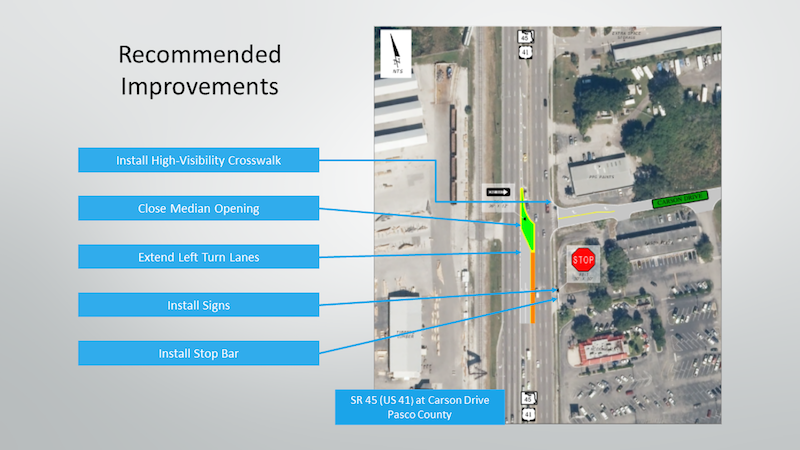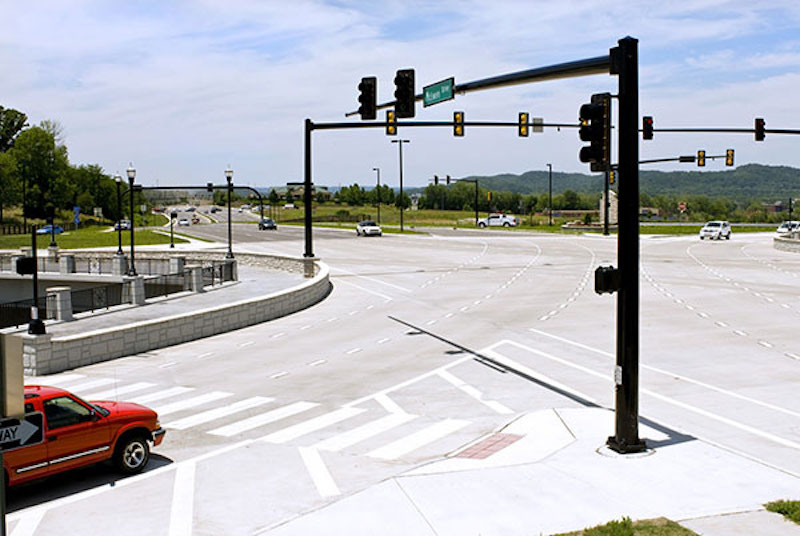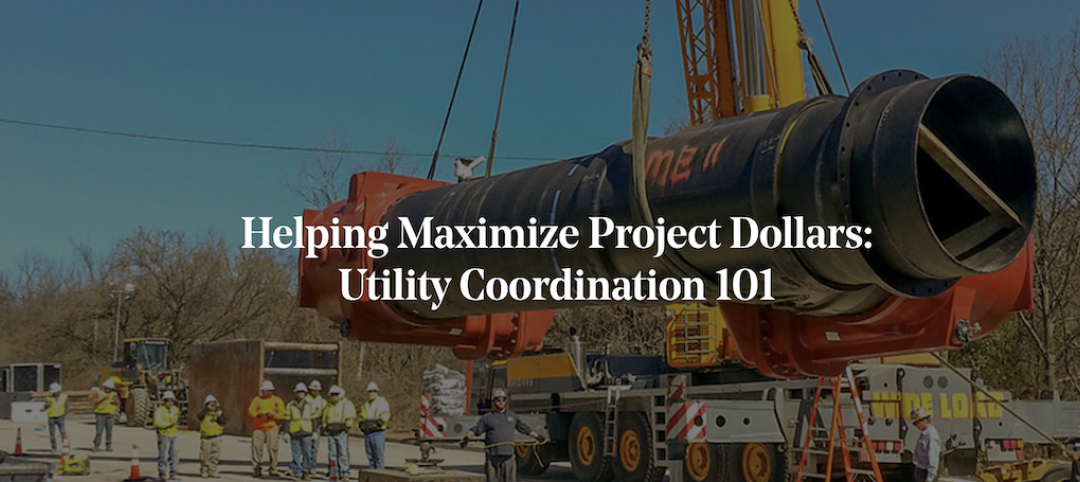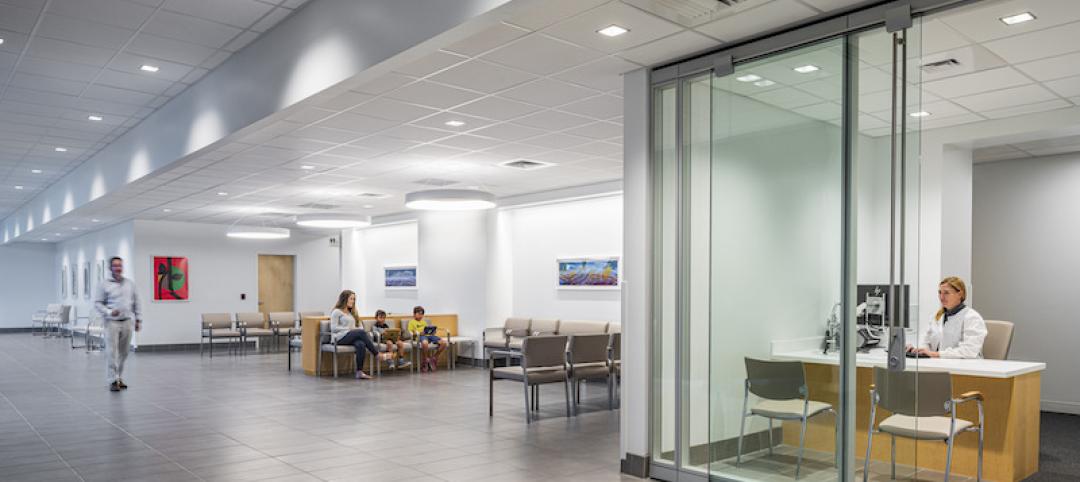As non-vehicular modes of transportation become increasingly popular, cities are working to address the safety needs of all modes of transportation, including vehicles, bikers and pedestrians. While there has been an emphasis on improving safety along corridors, it is equally important to focus on identifying potential safety issues at intersections. Intersections are a point in our roadway system where various traffic movements and modes of transportation directly conflict with one another. Signalized intersections naturally create a risk, but unsignalized intersections can pose a more serious driving hazard.
Under our District 7 Access Management Safety Studies contract with the Florida Department of Transportation (FDOT), Gresham, Smith and Partners has been working to address high crash locations within the District, which covers five counties in the Tampa Bay area. Specifically, we were tasked with evaluating 100 unsignalized intersections that had the highest crash severity index, which is determined by the number of fatal and serious injury crashes, and identifying short-term, mid-term and long-term solutions to identify and address future roadway improvement projects.
Based on initial discussions with FDOT’s District 7 and Central Office staff, we learned that the state’s top safety issues included rural lane departure crashes, intersection crashes, distracted drivers, wrong way drivers, and pedestrian and bicycle safety. To begin addressing FDOT’s concerns, we employed the strategies outlined in the 2016 Florida Strategic Highway Safety Plan, a set of guidelines created to reduce fatalities and injuries on Florida’s roadways, as well as provide multimodal accommodations. The plan shifts the focus from corridors to intersections, evaluating safety conditions as they relate to all users. To reduce the frequency and severity of crashes at intersections and reduce conflict risks, the plan suggests reviewing operations and safety for all intersection users, as well as evaluating crash data hot spots.
As we analyzed the high crash locations, our team worked to identify potential safety issues and remedial actions. In addition, the Federal Highway Administration’s Crash Modification Factors (CMF) Clearinghouse allowed us to use lifecycle cost and net present value formulas to do a benefit-cost analysis in determining viable improvements.
 The FHWA’s Crash Modification Factors Clearinghouse uses lifecycle cost and net present value formulas to do a benefit-cost analysis, which helps determine future projects.
The FHWA’s Crash Modification Factors Clearinghouse uses lifecycle cost and net present value formulas to do a benefit-cost analysis, which helps determine future projects.
As an example, when applied to the intersection of SR 45 (US 41) and Carson Drive in Pasco County, Florida, the CMF Clearinghouse analysis recommended the following short-term improvements:
- Install a high-visibility crosswalk across Carson Drive;
- Close the westbound median opening;
- Extend the southbound left-turn lanes;
- Install additional signage; and
- Install stop bars at the driveways in proximity to the intersection.
 Proposed improvements for SR 45 (US 41) at Carson Drive to create a safer unsignalized intersection.
Proposed improvements for SR 45 (US 41) at Carson Drive to create a safer unsignalized intersection.
After analyzing FDOT’s 100 high crash locations and using the FHWA’s Crash Modification Factors Clearinghouse, I drew two conclusions about addressing roadway safety at unsignalized intersections. First, I believe the focus on safety should shift from corridors to intersections, as the higher-risk locations need continuous safety monitoring. Second, I think that while long-term improvement projects may be inevitable at some locations, a number of short-term and mid-term improvements can take care of many roadway deficiencies. For improvements to be efficient, however, on-going processes should build off of previous improvements.
As transportation engineers and planners, it’s important that we encourage safe environments that support motorized and non-motorized modes of transportation. The number of pedestrians and bikers is growing, making intersection safety even more important. By working to identify high crash locations and developing both short-term and long-term improvement plans to address these areas, we can create communities that support all modes of transportation.
More from Author
Gresham Smith | Aug 17, 2023
How to design for adaptive reuse: Don’t reinvent the wheel
Gresham Smith demonstrates the opportunities of adaptive reuse, specifically reusing empty big-box retail and malls, many of which sit unused or underutilized across the country.
Gresham Smith | May 24, 2023
Designing spaces that promote enrollment
Alyson Mandeville, Higher Education Practice Leader, argues that colleges and universities need to shift their business model—with the help of designers.
Gresham Smith | Apr 24, 2023
Smart savings: Commissioning for the hybrid workplace
Joe Crowe, Senior Mechanical Engineer, Gresham Smith, shares smart savings tips for facility managers and building owners of hybrid workplaces.
Gresham Smith | Mar 20, 2023
3 ways prefabrication doubles as a sustainability strategy
Corie Baker, AIA, shares three modular Gresham Smith projects that found sustainability benefits from the use of prefabrication.
Gresham Smith | Jan 19, 2023
Maximizing access for everyone: A closer look at universal design in healthcare facilities
Maria Sanchez, Interior Designer at Gresham Smith, shares how universal design bolsters empathy and equity in healthcare facilities.
Gresham Smith | Dec 20, 2022
Designing for a first-in-the-world proton therapy cancer treatment system
Gresham Smith begins designing four proton therapy vaults for a Flint, Mich., medical center.
Gresham Smith | Nov 21, 2022
An inside look at the airport industry's plan to develop a digital twin guidebook
Zoë Fisher, AIA explores how design strategies are changing the way we deliver and design projects in the post-pandemic world.
Gresham Smith | Feb 13, 2022
Helping maximize project dollars: Utility coordination 101
In this post, I take a look at the utility coordination services our Transportation group offers to our clients in an attempt to minimize delays and avoid unforeseen costs.
Gresham Smith | May 7, 2021
Private practice: Designing healthcare spaces that promote patient privacy
If a facility violates HIPAA rules, the penalty can be costly to both their reputation and wallet, with fines up to $250,000 depending on the severity.
Gresham Smith | Mar 4, 2021
Behavior mapping: Taking care of the caregivers through technology
Research suggests that the built environment may help reduce burnout.
















